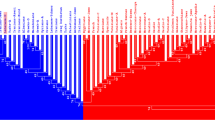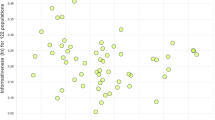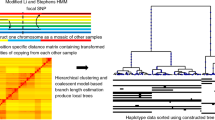Abstract
By analyzing the allelic frequencies at the D1S80 locus in 43 human populations, we show that the locus is polymorphic globally and that it can be used to discriminate between major racial groups and subpopulations through phylogenetic analysis. Although the use of informative multiple loci generally provides more accurate phylogenetic relationships, in instances where time and/or target DNA availability is limited, D1S80 could provide useful data to discriminate between human groups. Also, knowledge of which loci independently provide accurate phylogenetic relationships, such as the D1S80, can be used to design more accurate multi-locus combinations. In addition, allele frequencies at the locus are reported, for the first time, for Bahamian individuals of African origin and for Chimila, Bari, and Navajo (Cañoncito Valley) native Americans. Allelic data was obtained using standard polymerase chain reaction (PCR) techniques. In the four new populations, 65 genotypes and 20 segregating alleles were observed. All populations conformed to Hardy-Weinberg expectations except the Chimila.
Similar content being viewed by others
References
Batzer, M.A. & P.L. Deininger, 1991. A human-specific subfamily of Alu sequences. Genomics 9: 481–487.
Batzer, M.A., M. Stoneking, M. Alegria-Hartman, H. Bazan, D.H. Kass, T.H. Shaikh, G.E. Novick, P.A. Ioannou, W.D. Scheer, R.J. Herrera & P.L. Deininger, 1994. African origin of human-specific polymorphic Alu insertions. Proc. Nat. Acad. Sci. 91: 12288–12292.
Belich, M.P., A.J. Madrigal, W.H. Hildebrand, J. Zemmour, R.C. Williams, R. Luz, M.L. Petzi-Erier & P. Parham, 1992. Unusual HLA-B alleles in two tribes of Brazilian Indians. Nature 357: 326–329.
Boonlayangoor, P.W., T.A. Camp, R.S. Stephens & A.W. Boonlayangoor, 1994. Exclusion of paternity: confirmation by supplemental testing with DNA-PCR technology. Proceedings for the Fifth International Symposium on Human Identification, Promega Corp., Madison, USA.
Botstein, D., R.L. White, M. Skolnick & R.W. Davis, 1980. Construction of a genetic linkage map in a man using RFLP's. American Journal of Human Genetics 32: 314–331.
Budowle, B., F.S. Baechtel, J.B. Smerick, K.W. Presley, A.M. Giusti, G. Parsons, M.C. Alevy & R. Chakraborty, 1995. D1S80 population data in African Americans, Caucasians, Southeastern Hispanics, Southwestern Hispanics, and Orientals. Journal of Forensic Sciences 40: 38–44.
Budowle, B., R. Chakraborty, A.M. Giusti, A.J. Eisenberg & R.C. Allen, 1991. Analysis of the VNTR locus D1S80 by the PCR followed by high resolution page. American Journal of Human Genetics 48: 137–144.
Castro, A., I. Fernandez-Fernandez, A. Santos, C. Barbero, A. Garcia-Orad, G. Tamayo & M.M.de Pancorbo, 1995. D1S80 locus typing by micro thermal cycler. Application to Genetic Identity Testing. Journal of Forensic Sciences 40: 546–550.
Cavalli-Sforza, L.L. & A.W.F. Edwards, 1967. Phylogenetic analysis: models and estimation procedures. Evolution 21: 550–570.
Cavalli-Sforza, L.L., P. Menozzi & A. Piazza, 1994. The History and Geography of Human Genes. Princeton University Press, Princeton, NJ.
Chakraborty, R., L. Jin, Y. Zhong & R. Deka, 1993. Intra- and interpopulation variation at VNTR, short tandem repeat and polymarker loci and their implications in forensic and paternity analysis. Proceedings for the Fourth International Symposium on Human Identification, Promega Corp., Madison, USA.
Comey, C.T., B.W. Koons, K.W. Presley, J.B. Smerick, C.A. Sobieralski, D.M. Stanley & S.F. Baechtel. 1994. DNA extraction strategies for amplified fragment length polymorphism analysis. Journal of Forensic Science 39: 1264–1269.
Deka, R., S. DeCroo, L. Jin, M.T. Stephen, P. Rothhammer, R.E. Ferrell & R. Chakraborty, 1994. Population genetic characteristics of the D1S80 locus in seven human populations. Human Genetics 94: 252–258.
Edwards, A.W.F., 1971. Distance between populations on the basis of gene frequencies. Biometrics 27: 873–881.
Edwards, A.W.F., 1974. Distances Measures for Phylogenetic Trees, pp. 41–43 in Genetic Distance, edited by J.F. Crow and C. Denniston. Plenum Press, New York.
Edwards, A., H.A. Hammond, L. Jin, C.T. Caskey & R. Chakraborty, 1992. Genetic variation at five trimeric and tetrameric tandem repeat loci in four human population groups. Genomics 12: 241–253.
Felsenstein, J., 1993. PHYLIP (Phylogeny Inference Package) version 3.5e. Distributed by the author. Department of Genetics, University of Washington, Seattle.
Gill, P. & D.J. Werrett, 1987. Exclusion of a man charged with murder by DNA fingerprinting. Forensic Science International 35: 145–148.
Guo, S.W. & E.A. Thompson, 1992. Performing the exact test of Hardy-Weinberg proportion for multiple alieles. Biometrics 48: 361–372.
Hayes, J.M., B. Budowle & M. Freud, 1995. Arab population data on the PCR-base loci: HLA-DQA1, LDLR, GYPA, HBGG, D7S8, Ge and D1S80. Journal of Forensic Sciences 40: 888–892.
Heidrich, E.M., M.H. Hutz, F.M. Salzano, C. Coimbra & R.V. Santos, 1995. D1S80 locus variability in three Brazilian ethnic groups. Human Biology 67: 311–319.
Hochmeister, M.N., U.V. Borer & R. Dimhofer, 1994. Swiss Caucasian population data and casework-applications using PCR amplification kits. Proceedings for the Fifth International Symposium on Human Identification, Promega Corp., Madison, USA.
Jeffreys, A.J., J.F.Y. Brookfield & R. Semeonoff, 1986. DNA fingerprint analysis in immigration test cases. Nature 322: 290–291.
Jeffreys, A.J., J.F.Y. Brookfield & R. Semeonoff, 1985. Positive identification of an immigration test-case using human DNA fingerprints. Nature 317: 818–819.
Jeffreys, A.J., V. Wilson & S.L. Thein, 1985a. Hypervariable “minisatellite” regions in human DNA. Nature 314: 67–73.
Jeffreys, A.J., V. Wilson & S.L. Thein, 1985b. Individual-specific “fingerprints” of human DNA. Nature 316: 76–79.
Kadasi, L. & T. Bahusova, 1995. A new extremely large allele at the D1S80 (pMCT118) locus. Journal of Forensic Science 40: 906–907.
Kasai, K., Y. Nakamura & R. White, 1990. Amplification of a variable number of tandem repeats (VNTR) locus (pMCT118) by the polymerase chain reaction (PCR) and its application to forensic science. Journal of Forensic Science 35: 1196–1200.
Kjoosterman, A.D., B. Budowle & P. Daselaar, 1993. PCR-amplification and detection of the human D1S80 VNTR locus. Int. J. Leg. Med. 105: 257–264.
Klintschar, M., M. Kubat & A. Ebersold, 1995. The distribution of D1S80 (pMCT118) alleles in an Austrian population sample-description of two new alleles. Int. J. Leg. Med. 107: 225–226.
Lewontin, R.C. & J. Felsenstein, 1965. The robustness of homogeneity tests in 2 x N tables. Biometrics 21: 19–33.
Li, C.C., 1976. Pirst Course in Population Genetics. Boxwood Press, Pacific Grove, CA.
Livshits, G. & M. Nel, 1990. Relationships between intrapopulational and interpopulational genetic diversity in man. Ann. Hum. Biol. 17: 501–513.
Nagai, A., S. Yamada, Y. Bunai & I. Ohya, 1994. Analysis of the VNTR locus D1S80 in a Japanese population. Int. J. Leg. Med. 106: 268–270.
Nakamura, Y., M. Leppen, P. O'Connell, R. Wolff, T. Holm, M. Culver, C. Martin, E. Fujimoto, M. Hoff, E. Kumlin & R. White, 1987. Variable number of tandem repeat (VNTR) markers for human gene mapping. Science 235: 1616–1622.
Nei, M., 1972. Genetic distance between populations. Am. Nat. 106: 283–292.
Nei, M. & A.K. Roychoudhury, 1974. Sampling variances of heterozygosity and genetic distance. Genetics 76: 379–390.
Nei, M. & A.K. Roychoudhury, 1993. Evolutionary relationships of human populations on a global scale. Mol. Biol. Evol. 10: 927–943.
Nosikov, V.V., D.A. Chistyakov, D.K. Gavrilov, I.V. Ovchinnikov & M.V. Chelnokova, 1992. Analysis of PCR-based VNTR polymorphism within an East Slavonic population. European Society of Human Genetics 24th Annual Meeting, Helsingor, Denmark.
Novick, G.E., C.C. Novick, J. Yunis, E. Yunis, K. Martinez, G.G. Dunean, G.M. Troup, P.L. Deininger, M. Stoneking, M.A. Batzer & R.J. Herrera, 1995. Polymorphie human specific Alu insertions as markers for human identification. Electrophoresis 16: 1596–1601.
Novick, G.E., C.C. Novick, J. Yunis, E. Yunis, P. Antunez de Mayolo, W.D. Scheer, P.L. Deininger, M. Stoneking, M.A. Batzer & R.J. Herrera, 1996. On the Criental origin of native American populations. PNAS, submitted.
Perkin Elmer Corp. 1995. AmpliFLP D1S80 PCR Amplification Kit, Part #N808-0054 (instruction manual).
Reynolds, R., G. Sensabaugh & E. Blake, 1991. Analysis of genetic markers in forensic DNA samples using the polymerase chain reaction. Analytical Chemistry 63: 2–15.
Roff, D.A. & P. Bentzen, 1989. The statistical analysis of mitochondrial DNA polymorphisms and the problem of small samples. Mol. Biol. Evol. 6: 539–545.
Rogers, J.S., 1972. Measures of genetic similarity and genetic distance. Studies in Genetics, Univ. Texas Publ. 7213: 145–153.
Saiki, R.K., S.J. Scharf, F. Faloona, K.B. Mullis, G.T. Horn, H.A. Erlich & N. Arnheim, 1985. Enzymatic amplification of betaglobin genomic sequences and restriction site analysis for diagnosis of sickel cell anemia. Science 260: 1350–1354.
Sajantila, A., B. Budowle, M. Strom, V. Johnsson, M. Lukka, L. Peltonen & C. Ehnholm, 1992. PCR amplification of alleles at the D1S80 locus: comparison of a Finnish and a North American Caucasian population sample, and forensic casework evaluation. American Journal of Human Genetics 50: 816–825.
Sajantila, A., 1992. Application of the polymerase chain reaction in forensic medicine. Proceedings for the Third International Symposium on Human Identification, Promega Corp., Madison, USA.
Schanfield, M.S., T.A. Wahl, D. Latorra & J. Verret, 1993. Amplified fragment length polymorphisms (AFLPs) and DQA1 for forensic identification. Proceedings for the Fourth International Symposium on Human Identification, Promega Corp., Madison, USA.
Scholl, S., B. Budowle, K. Radecki & M. Salvo, 1996. Navajo, Puebio, and Sioux population data on the loci HLA-DQA1, LDLR, HBGG, D7S8, Gc, and D1S80. Journal of Forensic Sciences 41: 47–51.
Skowasch, K., P. Wiegand & B. Brinkmann, 1992. pMCT118 (D1S80): a new allelic ladder and an improved electrophoretic separation lead to the demonstration of 28 alleles. Int. J. Leg. Med. 105: 165–168.
Sokal, R.R. & F.J. Rohlf, 1981. Biometry, 2nd edition. W.H. Freeman and Company, San Fransico.
Sugiyama, E., K. Honda, Y. Katsuyama, S. Uchiyama, A. Tsuchikane, M. Ota & H. Fukushima, 1993. Allele frequency distribution of the D1S80 (pMCT118) locus polymorphism in the Japanese population by the polymerase chain reaction. Int. J. Leg. Med. 106: 111–114.
Thymann, M., L.J. Nellemann, G. Masumba, L. Irgens-Moller & N. Morling, 1993. Analysis of the locus D1S80 by amplified fragment length polymorphism technique (AMP-FLP). Frequency distribution in Danes. Intra and inter laboratory reproducibility of the technique. Forensic Science International 60: 47–56.
Walkinshaw, M., L. Strickland, H. Hamilton, K. Denning & T. Gayley, DNA profiling in two Alaskan native populations using HLA-DQA1, polymarker and D1S80 loci. Journal of Forensic Science (in press).
Wallace, D.C., K. Garrison & W.C. Knowler, 1985. Dramatic founder effects in Amerindian mitochondrial DNAs. American Journal of Physical Anthropology 68: 149–155.
Waye, J.S., D. Michaud, J.H. Bowen & R.M. Fourney, 1991. Sensitive and specific quantification of human genomic deoxyribonucleic acid (DNA) in forensic science specimens: casework examples. Journal of Forensic Science 36: 1198–1203.
Watkins, D.I., S.N. McAdam, X. Liu, C.R. Strang, E.L. Milford, C.G. Levine, T.L. Garber, A.L. Dogon, C.I. Lord, S.H. Ghim, G.M. Troup, A.l. Hughes & N.L. Lervin, 1992. New recombinant HLA-B alleles in a tribe of South American Amerindians indicated rapid evolution of MHC class 1 loci. Nature 357: 329–333.
Weir, B.S., 1992. Independance of VNTR alleles defined as fixed bins. Genetics 130: 873–887.
Woo, K.M. & B. Budowle, 1995. Korean population data on the PCR-based loci LDLR, GYPA, HBGG, D7S8, Ge, HLA-DQA1, and D1S80. Journal of Forensic Sciences 40: 645–648.
Wright, S., 1978. Evolution and the Genetics of Populations, vol. 4. Variability Within and Among Natural Populations. University of Chicago Press, Chicago.
Author information
Authors and Affiliations
Rights and permissions
About this article
Cite this article
Duncan, G., Thomas, E., Gallol, J.C. et al. Human phylogenetic relationships according to the D1S80 locus. Genetica 98, 277–287 (1996). https://doi.org/10.1007/BF00057592
Received:
Accepted:
Issue Date:
DOI: https://doi.org/10.1007/BF00057592




